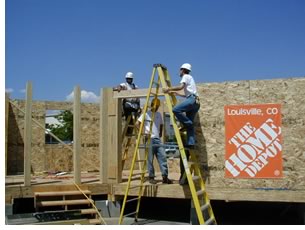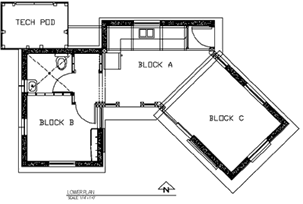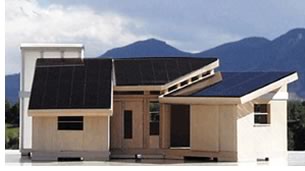

Psst! Wanna Buy a Solar
House?
University of Colorado puts 2002 Solar Decathlon
winner up for bid
 The
award-winning University of Colorado/Boulder Solar Decathlon house officially
is on the market, and the university is accepting sealed proposals for
purchase over the next month. Offers are due August
8, and a pre-bid information session and house tour will take place
July 22. (The school also offers regular public tours every Saturday,
10:00 a.m.–noon.)
The
award-winning University of Colorado/Boulder Solar Decathlon house officially
is on the market, and the university is accepting sealed proposals for
purchase over the next month. Offers are due August
8, and a pre-bid information session and house tour will take place
July 22. (The school also offers regular public tours every Saturday,
10:00 a.m.–noon.)
 Last
fall, teams of architecture, engineering, journalism, and business students
representing 14 universities took part in the first national Solar Decathlon.
They constructed 500-square-foot, 100-percent solar houses on the national
mall in Washington, D.C. Competing teams designed, financed (including
securing donations), tested, transported, built, operated, and fixed as
needed their energy-gathering houses. The competition was intended to
bring public attention to photovoltaic possibilities and energy efficiency.
Competition requirements included cooking meals, washing clothes, maintaining
a comfortable interior temperature in the unpredictable Washington early
autumn (it varied from sweltering and sunny to raining and muggy), water-temperature
testing, monitoring of battery levels, charging and operating electric
cars, operating a home office, publishing a Web page and newsletter, an
evaluation of construction documents, and, most importantly (it counted
for double the points of any other category), design and livability.
Last
fall, teams of architecture, engineering, journalism, and business students
representing 14 universities took part in the first national Solar Decathlon.
They constructed 500-square-foot, 100-percent solar houses on the national
mall in Washington, D.C. Competing teams designed, financed (including
securing donations), tested, transported, built, operated, and fixed as
needed their energy-gathering houses. The competition was intended to
bring public attention to photovoltaic possibilities and energy efficiency.
Competition requirements included cooking meals, washing clothes, maintaining
a comfortable interior temperature in the unpredictable Washington early
autumn (it varied from sweltering and sunny to raining and muggy), water-temperature
testing, monitoring of battery levels, charging and operating electric
cars, operating a home office, publishing a Web page and newsletter, an
evaluation of construction documents, and, most importantly (it counted
for double the points of any other category), design and livability.
 The
University of Colorado’s entry took first place in the fierce but
friendly competition. Entitled “Just About Any House,” the
school’s entry set out to prove that solar energy can work in any
“everyday American home.” Working with less than perfect pitch
for putting collectors on the roof, the team also chose to orient their
project more toward passersby than optimum energy production. Basic modules
of structural insulated panels (SIPs) form the primary building blocks
of the house so that the design can be modified and adapted to any site.
The core module, the brain of the house, contains the building’s
utilities, monitors, and controls. In addition to its photovoltaic system
for electricity, the house uses evacuated tube collectors to capture solar
thermal energy for domestic hot water.
The
University of Colorado’s entry took first place in the fierce but
friendly competition. Entitled “Just About Any House,” the
school’s entry set out to prove that solar energy can work in any
“everyday American home.” Working with less than perfect pitch
for putting collectors on the roof, the team also chose to orient their
project more toward passersby than optimum energy production. Basic modules
of structural insulated panels (SIPs) form the primary building blocks
of the house so that the design can be modified and adapted to any site.
The core module, the brain of the house, contains the building’s
utilities, monitors, and controls. In addition to its photovoltaic system
for electricity, the house uses evacuated tube collectors to capture solar
thermal energy for domestic hot water.
Visit the school’s Web site for more information, including the formal request for offers and documentation on the design, construction, and performance of the house.
Copyright 2003 The American Institute of Architects.
All rights reserved. Home Page ![]()
![]()
 |
||
| For more
information, contact Michael J. Brandemuehl, PhD, PE Visit the University of Colorado’s Solar Decathlon Web site.
Read about the 2002 Solar Decathlon.
|
||